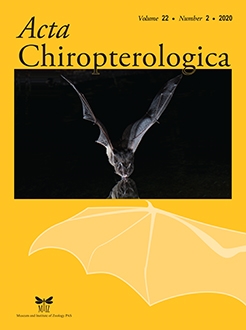Bats have a major functional role in wetlands; understanding how functional traits of bats depend on environmental characteristics can facilitate management of ecosystems and their services. In this study, we investigated how bat functional diversity has been affected by different anthropogenic impacts in wetlands of the Trans-Andean tropical dry forest of Colombia. Specifically, we analyzed how different functional traits responded to changing environmental conditions and land use and land cover patterns. We sampled six wetlands during the dry periods of the hydrological cycle from 2014 to 2018 and modeled the functional diversity as a function of environmental variables. To understand the association of bat community structure with environmental variables and biotic factors, we combined the RLQ analysis and the fourth-corner approach to relate environmental characteristics and species traits. The percentages of water surface area and pasture land were found to be associated with the general traits of bats when analyzed using the relative abundance of species. In addition, changes in functional diversity appeared to be driven mainly by larger species (e.g., Phyllostomus hastatus, Artibeus lituratus), whose presence was primarily associated with heterogeneous areas. The fourth-corner analysis revealed that the greatest length of skull is the trait that best describes the presence of bats in landscapes of pastures, water bodies, and high abundance of the shrubs Vismia sp. and Cecropia sp. These results suggest that combinations of specific features are important drivers of variation in functional diversity between wetlands. Considering the high vulnerability of Colombian wetlands, our findings provide fundamental information for the development of strategies for monitoring wetland biodiversity. The results can help identify priority conservation sites and improve environmental decision making.
How to translate text using browser tools
1 December 2020
Functional Traits of Bats Associated with the Use of Wetlands in Colombian Tropical Dry Forests
Leidy V. Garcia-Herrera,
Leidy A. Ramírez-Fráncel,
Sergio Losada-Prado,
Gladys Reinoso-Flórez,
Francisco A. Villa-Navarro,
Giovany Guevara
ACCESS THE FULL ARTICLE

Acta Chiropterologica
Vol. 22 • No. 2
December 2020
Vol. 22 • No. 2
December 2020
fourth-corner analysis
functional diversity
land cover
RLQ analysis




